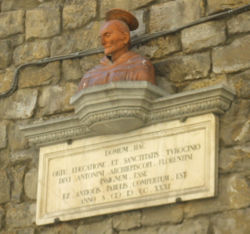- Antoninus of Florence
-
For others known as Saint Anthony, see Saint Anthony (disambiguation).
Saint Antoninus
Bust outside the home of Saint Antoninus, Torre dei Pierozzi. Florence, Italy.Bishop and Confessor Born March 1, 1389
Florence, ItalyDied May 2, 1459 (aged 70)
MontughiHonored in Roman Catholic Church Canonized 1523, Rome by Pope Adrian VI Feast May 2; May 10 (General Roman Calendar, 1683–1969) Patronage Moncalvo, near Turin, University of Santo Tomas Graduate School Antoninus of Florence (Anthony of Florence, Antonio Pierozzi, also called De Forciglioni) (1 March 1389 – 2 May 1459) was an archbishop of Florence.
Born in the city of Florence, he entered the Dominican order in his 16th year. Soon, in spite of his youth, he was with the government of various houses of his order at Cortona, Rome, Naples and Florence, which he labored zealously to reform. He was involved in the establishment of the convent of San Marco, Florence. The convent's cells, including one for Cosimo de' Medici, were painted in fresco by Fra Angelico and his assistants.
Antoninus was consecrated Archbishop of Florence in 1446 on the initiative of Pope Eugene IV, and won the esteem and love of his people, especially by his energy and resource in combating the effects of the plague and earthquake in 1448 and 1453. Antoninus lived a life of austerity as archbishop. His relations with the Medici regime were close but not always harmonious. He died on 2 May 1459, and Pope Pius II conducted his funeral. (The pope was on his way to the Council of Mantua when he heard of the archbishop's death.)
Antoninus had a great reputation for theological learning, and sat as a papal theologian at the Council of Florence. Of his various works, the list of which is given in Quétif-Échard, De Scriptoribus Ordinis Praedicatorum, vol. i.818, the best-known are his Summa theologica (Venice, 1477; Verona, 1740) and the Summa confessionalis, Curam illius habes (Mondovi, 1472), invaluable to confessors. (This is one of three guides for confessors he wrote.) His writings, some in Italian, reflect a pronounced awareness of the problems of social and economic development. He argued in them that the state had a duty to intervene in mercantile affairs for the common good, and the obligation to help the poor and needy. His viewpoint on vanity of women's dress made concessions to the social status of women of high birth or married to holders of high office.
Because of his small stature, he was also called 'Little Anthony' (Antonino).
He is also the Patron Saint of Moncalvo, near Turin.
Saint Antoninus was canonized by Pope Adrian VI, who himself held ideas of radical and drastic church reform similar to that of Antoninus.
Saint Antoninus' feast day, which was not in the Tridentine Calendar, was inserted in the General Roman Calendar in 1683, for celebration on 10 May[1] as a Double, a rank altered in 1960 to that of Third-Class Feast. Since 1969, it is no longer in the General Roman Calendar, but the Roman Martyrology indicates that it is still observed, moved to 2 May, the day of his death.[2]
References
- ^ Calendarium Romanum (Libreria Editrice Vaticana 1969), p. 122
- ^ Martyrologium Romanum (Libreria Editrice Vaticana, 2001 ISBN 88-209-7210-7)
 This article incorporates text from a publication now in the public domain: Chisholm, Hugh, ed (1911). Encyclopædia Britannica (11th ed.). Cambridge University Press.
This article incorporates text from a publication now in the public domain: Chisholm, Hugh, ed (1911). Encyclopædia Britannica (11th ed.). Cambridge University Press.
External links
- Saint Antoninus in The Lives or the Fathers, Martyrs and Other Principal Saints
- Saint Antonius in the Catholic Forum
- Catholic Encyclopedia: St. Antoninus
Categories:- 1389 births
- 1459 deaths
- People from Florence
- Members of the Dominican Order
- 15th-century Christian saints
- Economic history of the Holy See
- Medieval Italian saints
Wikimedia Foundation. 2010.

